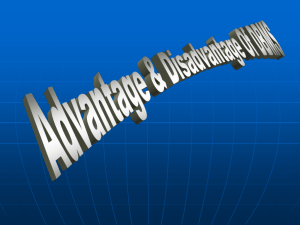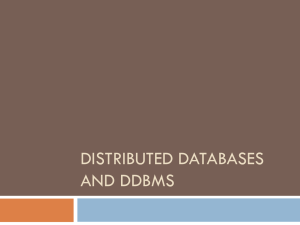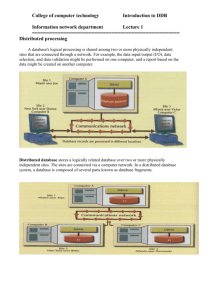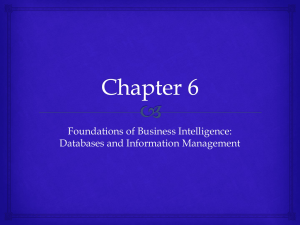Minggu 12, Pertemuan 23 Introduction to Distributed DBMS Matakuliah
advertisement
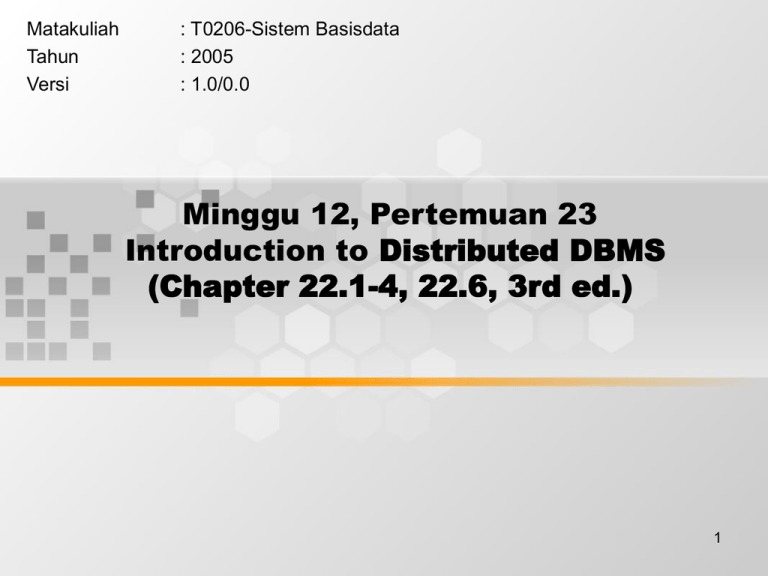
Matakuliah Tahun Versi : T0206-Sistem Basisdata : 2005 : 1.0/0.0 Minggu 12, Pertemuan 23 Introduction to Distributed DBMS (Chapter 22.1-4, 22.6, 3rd ed.) 1 Learning Outcomes Pada akhir pertemuan ini, diharapkan mahasiswa dapat dapat Menjelaskan konsep dan masalah distributed DBMS (C2) 2 Outline Materi • Concepts. • Advantages and disadvantages of distributed databases. • Functions and architecture for a DDBMS. • Distributed database design. 3 Concepts Distributed Database A logically interrelated collection of shared data (and a description of this data), physically distributed over a computer network. Distributed DBMS Software system that permits the management of the distributed database and makes the distribution transparent to users. 4 Concepts • • • • • • • Collection of logically-related shared data. Data split into fragments. Fragments may be replicated. Fragments/replicas allocated to sites. Sites linked by a communications network. Data at each site is under control of a DBMS. DBMSs handle local applications autonomously. • Each DBMS participates in at least one global application. 5 Distributed DBMS 6 Distributed Processing A centralized database that can be accessed over a computer network. 7 Parallel DBMS A DBMS running across multiple processors and disks designed to execute operations in parallel, whenever possible, to improve performance. • Based on premise that single processor systems can no longer meet requirements for cost-effective scalability, reliability, and performance. • Parallel DBMSs link multiple, smaller machines to achieve same throughput as single, larger machine, with greater scalability and reliability. 8 Parallel DBMS • Main architectures for parallel DBMSs are: – Shared memory, – Shared disk, – Shared nothing. 9 Parallel DBMS (a) shared memory (b) shared disk (c) shared nothing 10 Advantages of DDBMSs • Reflects organizational structure • Improved shareability and local autonomy • Improved availability • Improved reliability • Improved performance • Economics • Modular growth 11 Disadvantages of DDBMSs • • • • • • • Complexity Cost Security Integrity control more difficult Lack of standards Lack of experience Database design more complex 12 Types of DDBMS • Homogeneous DDBMS • Heterogeneous DDBMS 13 Homogeneous DDBMS • All sites use same DBMS product. • Much easier to design and manage. • Approach provides incremental growth and allows increased performance. 14 Heterogeneous DDBMS • Sites may run different DBMS products, with possibly different underlying data models. • Occurs when sites have implemented their own databases and integration is considered later. • Translations required to allow for: – Different hardware. – Different DBMS products. – Different hardware and different DBMS products. • Typical solution is to use gateways. 15 Components of a DDBMS 16 Distributed Database Design • Three key issues: – Fragmentation, – Allocation, – Replication. 17 Distributed Database Design Fragmentation Relation may be divided into a number of sub-relations, which are then distributed. Allocation Each fragment is stored at site with “optimal” distribution. Replication Copy of fragment may be maintained at several sites. 18 Fragmentation • Definition and allocation of fragments carried out strategically to achieve: – Locality of Reference. – Improved Reliability and Availability. – Improved Performance. – Balanced Storage Capacities and Costs. – Minimal Communication Costs. • Involves analyzing most important applications, based on quantitative/qualitative information. 19 Fragmentation • Quantitative information may include: – frequency with which an application is run; – site from which an application is run; – performance criteria for transactions and applications. • Qualitative information may include transactions that are executed by application, type of access (read or write), and predicates of read operations. 20 Data Allocation • Four alternative strategies regarding placement of data: – Centralized, – Partitioned (or Fragmented), – Complete Replication, – Selective Replication. 21 Data Allocation Centralized Consists of single database and DBMS stored at one site with users distributed across the network. Partitioned Database partitioned into disjoint fragments, each fragment assigned to one site. 22 Data Allocation Complete Replication Consists of maintaining complete copy of database at each site. Selective Replication Combination of partitioning, replication, and centralization. 23 Comparison of Strategies Data Distribution for 24 Date’s 12 Rules for a DDBMS 0. Fundamental Principle To the user, a distributed system should look exactly like a nondistributed system. 1. 2. 3. 4. 5. 6. Local Autonomy No Reliance on a Central Site Continuous Operation Location Independence Fragmentation Independence Replication Independence 25 Date’s 12 Rules for a DDBMS 7. 8. 9. 10. 11. 12. Distributed Query Processing Distributed Transaction Processing Hardware Independence Operating System Independence Network Independence Database Independence • Last four rules are ideals. 26


